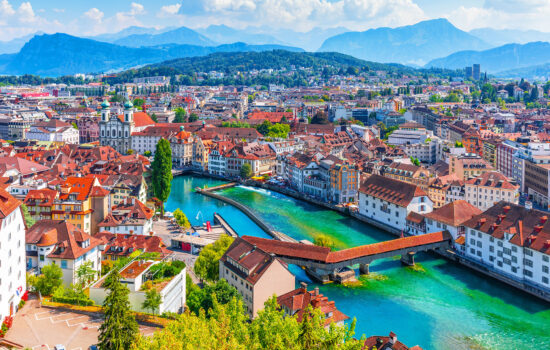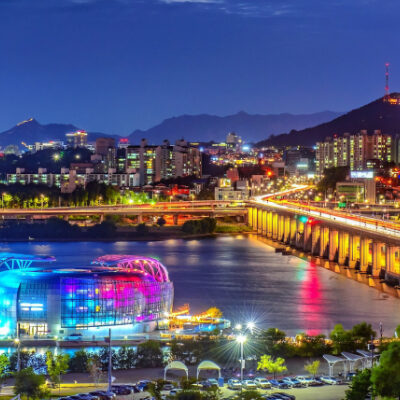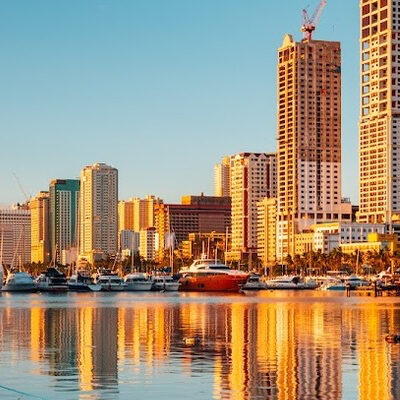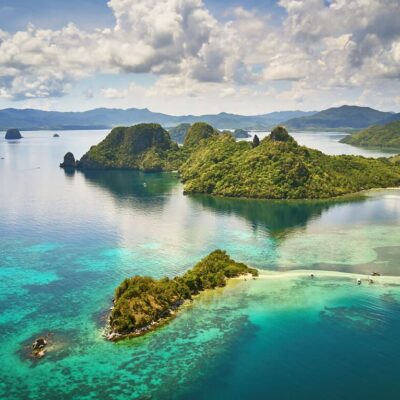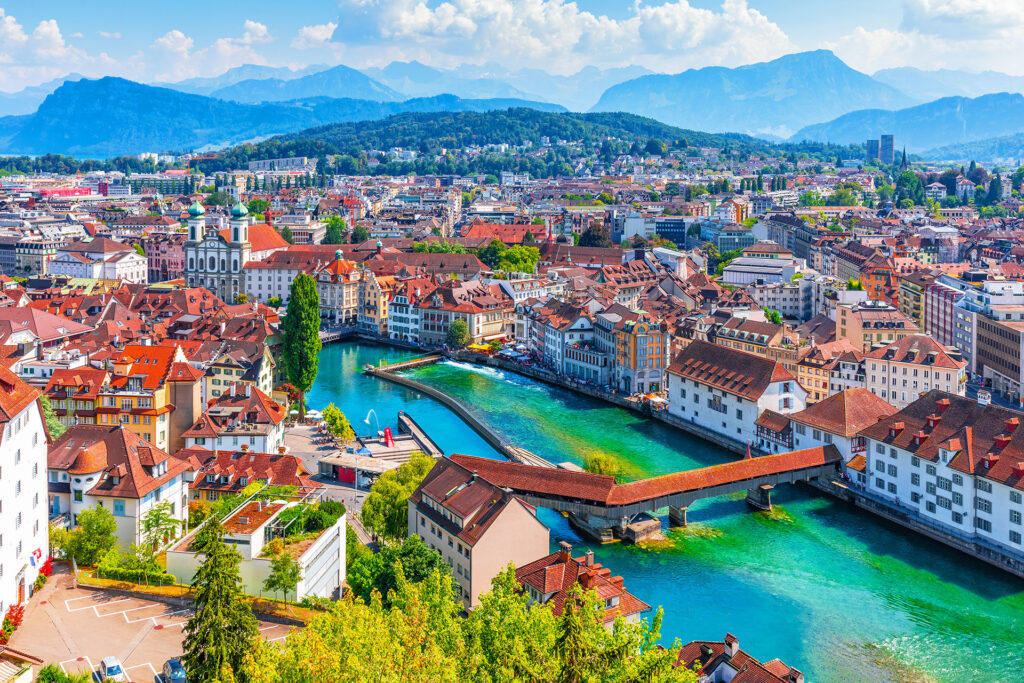
Lucerne sits tucked between snowy peaks and a sparkling lake, blending natural beauty with history and culture. Whether visiting for a day or longer, this Swiss city has plenty to offer. Medieval buildings stand in contrast to mountain views, creating a storybook vibe that’s great for photos and feels magical. Explore art spots, walk historic bridges, head up mountains, or relax on a lake cruise. So many options to fill your time.
When planning your own list of best things to do in Lucerne, focus on mixing iconic sights with laid-back moments. Wander, take in views, enjoy simple pleasures. You’ll likely want to come back before you’ve even left.
Crossing Time: The Iconic Chapel Bridge
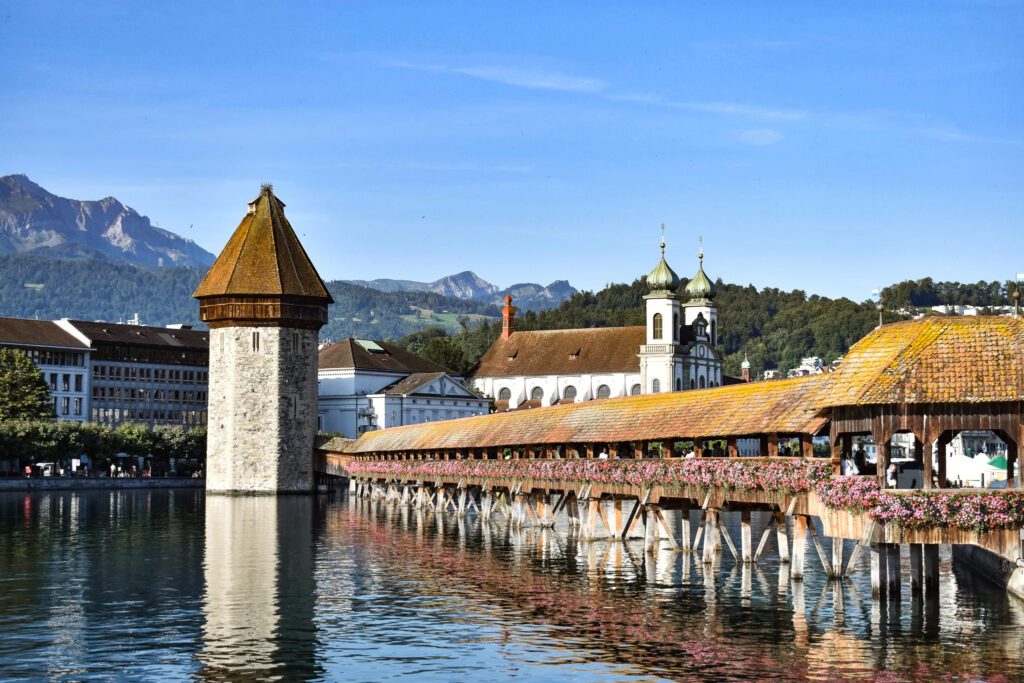
Don’t miss Chapel Bridge when in Lucerne. Dating back to the 1300s, this iconic wooden structure isn’t just for crossing the Reuss River—it feels like stepping into history. Up above, faded triangular paintings line the roof, showing moments from Switzerland’s past. A fire in ’93 destroyed some panels, but plenty remain, telling stories as you walk. Beside it stands a 13th-century water tower, once used as a jail, treasury, and even a place for interrogations.
Come dusk, soft golden lights turn the bridge into something straight from a storybook, blending old-world charm with today’s magic.
Colorful Stories: The Painted Buildings of the Altstadt
Strolling through Lucerne’s Old Town is like walking into a storybook. Buildings here aren’t just structures—they’re giant storyboards! Their painted fronts share tales from history, legends, and past residents’ jobs. Bright frescoes show knights, myths, and shopkeepers from long ago.
Head to Weinmarkt Square for standouts like Pfistern Guild House. This Renaissance gem’s walls burst with color, showing scenes from its heyday. Check out the old Zum Mohren pharmacy building. Its walls feature foreign-inspired designs hinting at where healing herbs came from.
Floating Paradise: Lake Lucerne Boat Cruise
For things to do in Lucerne, Switzerland, heading out on water ranks high. Lake Lucerne’s clear waters mirror Alps, offering stunning views everywhere. Locally called Vierwaldstättersee, this twisty lake has bays and arms that shift views as you sail. Trips vary from quick 1-hour rides to day-long journeys stopping at villages like Vitznau or Brunnen. Historic paddle steamers bring nostalgic vibes, engines humming as peaks glide by. Most boats serve Swiss classics—imagine dipping fondue as mountains pass your window. Aim for sunrise or dusk sails when light washes peaks in pink or gold, and water shimmers.
Timeless Charm: Lucerne’s Picturesque Old Town
When it comes to Lucerne, things to do begin in its car-free Old Town. Cobblestone lanes twist past medieval buildings, mixing history with relaxed energy. Architecture here spans Gothic to Baroque styles, each era etched in stonework. Catch street musicians performing near shops where chocolatiers shape pralines behind glass. Hunt for souvenirs between market stalls piled with alpine cheese, seasonal blooms, and handmade crafts.
Check Zyt Tower’s astronomical clock—it chimes first, a quirky local pride. Medieval fountains still flow with drinkable mountain water; bring empty bottle to join residents filling up.
No traffic hum lets church bells dominate the soundscape, ringing clear as they did when knights patrolled these streets.
Danse Macabre: The Haunting Spreuer Bridge
Chapel Bridge draws crowds, but don’t skip its lesser-known sibling. Spreuer Bridge (Spreuerbrücke) showcases 67 haunting 17th-century panels called “Dance of Death.” Each painting has a skeleton guiding people—popes, farmers, kids, elders—showing death doesn’t care about status. Name “Spreuer” comes from when millers tossed chaff into the river here. Like Chapel Bridge, it once helped protect the city and gave locals shelter.
Being a bit out of the way, you can take your time with the art without dodging tourists. Sure, it’s dark stuff, but there’s a strange beauty in these old reminders of mortality, framed by flowing water and peaks.
Medieval Marvels: Musegg Wall & Towers
What to do in Lucerne? Explore Musegg Wall with its nine towers—it makes a great way to spend an afternoon. Built in the 1300s, this defensive stone structure shows how Lucerne protected itself back in medieval times. Running nearly a kilometer along hills above Old Town, the wall’s stood guard since 1386. Its towers once scanned for threats across the landscape.
Four towers let visitors inside. Don’t miss Zyt Tower with Lucerne’s oldest clock from 1535—it still rings one minute earlier than other city clocks! Männli Tower has a tiny automaton marking time, while Wacht Tower once held prisoners. Walking between towers along ramparts feels like time travel. Peek through original arrow slits in thick walls where defenders once stood.
Climbing steps might wind you, but views from up top? Worth every step—you’ll see city rooftops, the lake, and mountain peaks spread out below.
Artistic Treasure: Sammlung Rosengart
Art lovers, take note: Sammlung Rosengart packs a punch. This museum holds an impressive stash of modern art collected by Angela Rosengart and her father. Angela wasn’t just a gallery owner—she became pals with giants like Picasso, who sketched her portrait more than once. That personal touch shines through. Housed in a revamped bank building near the train station, the space features 300+ works from heavyweights like Picasso, Klee, Miró, and Chagall.
Picasso’s works here track four decades of his career, from bold Cubist experiments to playful later pieces. Upstairs, Paul Klee gets his moment—a full floor of whimsical watercolors and precise sketches, forming one of the largest gatherings of his art worldwide. Lighting and layout are spot-on, letting you catch tiny details in brushstrokes or pencil marks.
Audio guides stick to key stories, avoiding info overload. Best part? You can see everything without feeling fried. No endless halls, no crowds—just art and the folks who clearly loved it.
Stone Emotion: The Moving Lion Monument
Mark Twain once said this stone carving ranked as “the most mournful and moving… in the world.” Standing before the Lion Monument, you’ll see why. Sculptor Lukas Ahorn spent a year chiseling this 10-meter-long figure straight into sandstone between 1820-21. Picture a wounded lion collapsed on its side, spear jutting from its flank. One paw drapes over a shield marked with French royal symbols—a tribute to Swiss mercenaries killed defending King Louis XVI during the 1792 Paris uprising.
What grabs people isn’t the size, though that’s striking. It’s the lion’s face. Half-closed eyes, slack muzzle—visitors often freeze, struck by how stone can radiate such raw ache. Surroundings amplify the mood: dappled light through trees, quiet broken only by water dripping into a pond below the cliff. For a spot just blocks from Lucerne’s busy streets, the hushed vibe feels worlds apart.
Elevated Elegance: Château Gütsch by Funicular
Hop on Gütsch’s vintage funicular—it’s been whisking folks uphill since 1884. At the top sits Château Gütsch, a white-turreted castle turned hotel that’s been gazing over Lucerne since the late 1800s. No need to book a room here, though. Just step off the creaky carriage (the ride covers 100 meters quickly!) and head straight for the terrace.
From up here, Lucerne unfolds like a postcard: cobalt lake, red rooftops, and mountains Pilatus and Rigi framing it all. Menus offer Swiss classics with a twist, and yeah, dishes that fit the fancy setting.
Stick around as daylight fades. Morning fog lifts off water, noon sun sharpens distant ridges, and sunset? That’s when mountains blush pink before city lights sparkle awake below. No wonder this spot keeps popping up in things to see in Lucerne guides.
Cultural Beacon: KKL Luzern
KKL Luzern, the city’s culture and convention center, embodies modern Lucerne at its best. Jean Nouvel, a Pritzker Prize-winning architect, designed this sleek landmark, which opened in 2000. Inside, you’ll find a top-tier concert hall, rotating art exhibits, and lakeside dining. Nouvel blended the structure into its surroundings with mirror-like pools and oversized windows showcasing mountains and the lake.
At its heart is a concert hall praised for flawless acoustics. Natural materials like aged wood line walls and ceilings, adding warmth while shaping sound. Russell Johnson, a leading acoustician, helped perfect the space. Check schedules for performances by the Lucerne Symphony Orchestra or global artists, especially during the famed Lucerne Festival.
Art lovers can explore the Kunstmuseum’s ever-changing exhibits, which highlight Swiss and international creators. For views, head up to the rooftop terrace. When weather’s nice, the ground-floor restaurant spills onto a terrace right by the water.
Green Retreat: Inseli Park
Need a break from ticking off what to see in Lucerne lists? Inseli Park, steps from the train station, gives that green reset without fuss. Built on 19th-century reclaimed land, it’s a shared spot where everyone—tourists, teens with guitars, grandparents with newspapers—mixes easily.
Stroll the waterfront path for mountain views that don’t quit. Trees throw shade when the sun gets pushy. Swans paddle close enough to toss breadcrumbs, boats bob past like moving postcards, and yeah, you’ll spot slacklines strung between trees most afternoons. Come summer, maybe catch a movie screening or live music—just don’t overplan it.
Picnics beat pricey restaurant meals here. No grand monuments or ticket lines, just Alps framing ordinary moments. Turns out Lucerne’s magic isn’t only in guidebook highlights.
Spiritual Square: Franziskanerplatz & Franciscan Church
Franziskanerplatz gives a quiet escape from busier districts. At its heart stands Franciscan Church—plain on the outside, but step through its doors to find a lavish baroque interior. This contrast mirrors the Franciscans’ shift over centuries, from strict simplicity to embracing more decorative styles. Inside, intricate stucco details twist across walls, while ceiling paintings tell stories of St. Francis and other religious figures. Though founded in the 1200s, much of what you see today comes from a 1700s renovation, blending medieval bones with baroque flair.
The square itself feels like a community hub. Café tables spill onto cobblestones where neighbors trade gossip, and a fountain’s soft splash fills pauses in conversation. Unlike crowded spots near Chapel Bridge, this place stays rooted in local rhythms. Buildings lining the square whisper of Lucerne’s past: guild halls with weathered beams, merchant homes sporting faded crests. Small shops sell handmade chocolates, carved wood trinkets, and other regional specialties—no mass-produced souvenirs here.
Baroque Splendor: Jesuit Church
Along the Reuss River, Switzerland’s first large baroque church makes a striking impression. Inside, white walls mix with pink marble and detailed stucco patterns, balancing calm and grand vibes against Switzerland’s plainer Protestant spaces. Constructed from 1666 to 1673 amid the Counter-Reformation, this church served as a Catholic answer to Protestant minimalism, using art to spark faith. Its spot by Chapel Bridge wasn’t random—positioned to catch the eyes of crossers, it quietly announced Catholic influence.
Glance up, and you’ll see ceiling paintings telling stories of Saint Francis Xavier, a key Jesuit figure. Marble columns with gold touches frame side altars, showing off skilled work from centuries past. Sound here shines too, with music events letting notes bounce off walls as much as light does. A 1982 pipe organ, styled like older instruments, adds deep melodies during shows. Even a quick visit gives a peaceful break while exploring Lucerne attractions.
By the river, big windows shift sunlight across walls and floors all day, keeping the mood inside this baroque gem fresh. No two moments look quite the same.
Twin-Towered Treasure: Church of St. Leodegar
Twin spires rise over Lucerne at St. Leodegar’s Church, known locally as Hofkirche. It’s a city icon. First built as a Benedictine monastery way back in the 700s, today’s church mostly comes from Renaissance rebuilding after a 1633 fire. Only original towers, crypt, and some walls made it through flames. This spot’s central to Lucerne’s growth—the city literally formed around it, mixing faith and history in one place.
Inside, a massive 5,800-pipe organ shakes walls during regular concerts. Carved choir stalls from 1639 pack details: bible stories, mythical beasts in wood. Gilded pulpit glimmers when sunlight hits from those tall windows. Side altars mix paintings and sculptures showing religious art trends over centuries.
Perched on a hill, the forecourt gives nice city views. Grounds stay quiet, perfect for resting tired feet after exploring. Graveyard around the church blends art with rest—sculptures adorn old graves. Still a working church, so you could walk into hushed prayers or full choir performances—each adds a unique vibe to the place.
Wheels, Wings & Wonders: Swiss Museum of Transport
Checking out top things to do in Lucerne lists? The Swiss Museum of Transport should sit high. Far from a dusty museum, it’s a sprawling, hands-on space where trains, planes, and diggers take center stage. Since 1959, this spot’s kept growing—now Switzerland’s most-visited museum. It’s got roots in how the country tackled tough terrain, especially with railways. Hop into vintage cogwheel trains that once scaled Alps, poke around cockpits from old biplanes to sleek jets, or test-drive construction gear.
Car fans get a timeline of vehicles, from early models to modern rides, while boat simulators let you navigate virtual waters. Beyond transport, there’s a planetarium beaming star shows, an IMAX screen for jaw-dropping films, and even a chocolate zone (yes, Lindt made it) where you follow cocoa’s journey. Media buffs can play news anchor in a faux studio. Outside, real planes and trains dot the grounds, plus a chunk of tunnel-boring tech from Gotthard Base Tunnel.
Half a day? Bare minimum. Many end up staying longer—there’s a café for snacks and spots to picnic. If you’ve ever wondered how Switzerland nailed its rep for smart engineering, this place breaks it down without boring lectures. Just pure, button-pushing, gear-shifting fun.
Practical Tips for Your Lucerne Adventure
When it comes to Lucerne, Switzerland, things to do often start on foot—its compact center is perfect for wandering. Sturdy shoes help on cobblestone lanes, though. Grab a Swiss Travel Pass if you’ll ride trains or buses a lot—it covers museums and cuts mountain trip costs.
Check winter hours from November to March—some spots shut down early. For crowd-free Chapel Bridge photos, come early. Soft morning light hits the mountains behind it nicely.
The answer to “what to do in Lucerne, Switzerland” often involves water activities. Pack layers if doing boat rides or lake walks—conditions shift fast. Alpine weather switches too. Toss a foldable raincoat in your bag, even if skies look clear.
Most stores stay closed Sundays, but eateries and museums stay open. Save shopping for weekdays. Hit the tourist desk by the train station—they’ve got maps, tips, and local know-how.
Summer brings lakeside dining. Book ahead for top spots at dinner. Fill your bottle at street fountains—Alpine water’s free and tastes great.
Summing Up
Medieval architecture, iconic art, mountain vistas—Lucerne doesn’t hold back. This Swiss spot blends old-world charm with modern energy, keeping first-timers and regulars hooked. Wander streets and you’ll find snapshots worth remembering: swans skating across water, golden light hitting snow-capped ridges.
When it comes to Lucerne, things to do stack up without hassle. Compact size means less transit time, more exploring. Base yourself here, and day trips to nearby peaks or villages become effortless. Trains and buses? They’re punctual. Attractions? Neatly kept. Everything’s set up for smooth adventures.
But it’s not all clockwork precision. Summer brings a chill vibe—cafés spill outdoors, chatter bounces off lake surfaces, and evenings stretch lazily. Pack comfy shoes and a camera. Your main issue won’t be finding activities; it’ll be choosing what to skip.
